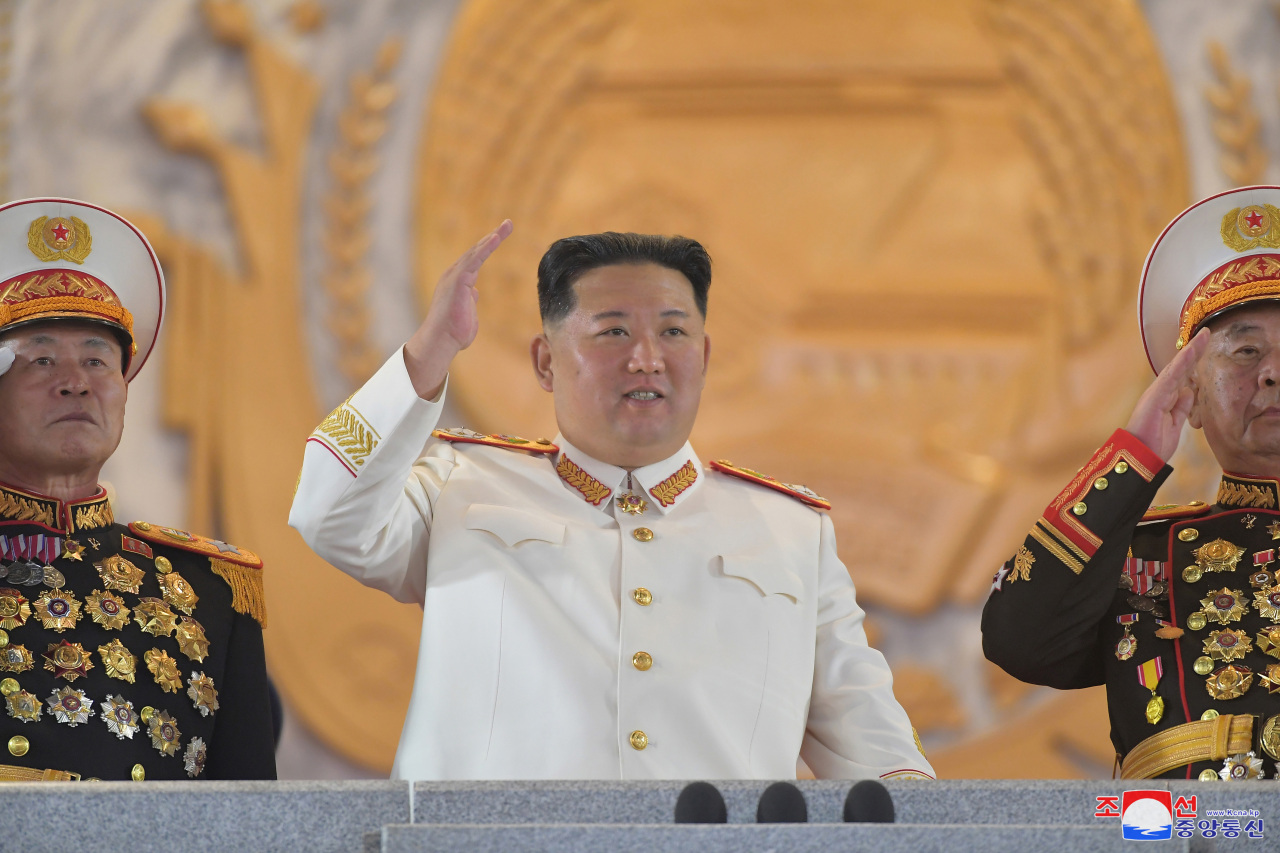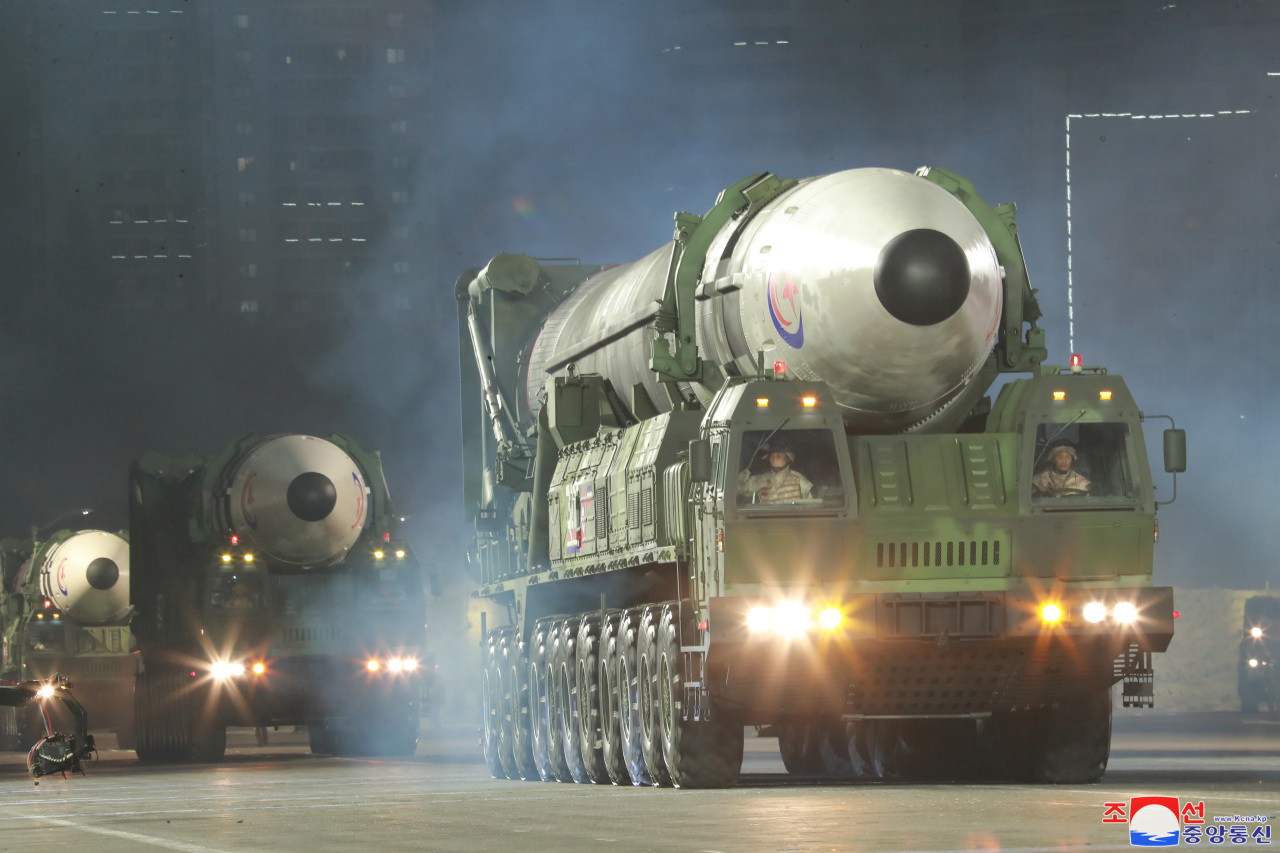 |
North Korean leader Kim Jong-un (C) waves during a military parade at Kim Il-sung Square in Pyongyang on Monday to mark the 90th anniversary of the founding of its army, in this photo released the next day by the North`s official Korean Central News Agency. (Yonhap) |
The North Korean leader pledged to further reinforce and develop nuclear-armed forces “at the fastest possible speed,” suggesting that North Korea can launch a preemptive nuclear strike if adversaries violate the country’s “fundamental interests.”
General Secretary Kim Jong-un on Monday delivered a speech during a nighttime massive military parade held at the Kim Il-sung Square in the capital Pyongyang, North Korea state-run Korean Central News Agency reported Tuesday.
The military parade, which displayed intercontinental ballistic missiles and strategic weapons, was held to commemorate the 90th anniversary of the founding of the Korean People’s Revolutionary Army on April 25.
Kim, in military uniform, said the current situation calls for North Korea to “take more proactive measures to permanently and firmly guarantee the modernity and military and technological strength of the armed forces of the DPRK.”
The North Korean leader underscored that his country “must strengthen nuclear-armed forces, which is a symbol of national power and the basis of the country’s military power, in quality and quantity.”
“We will step toward the path to build self-defense and modern armed forces faster and more steadily, which we have walked along relentlessly, in preparation for the turbulent political and military situation and all kinds of crises in the future,” Kim said.
“In particular, we will continue to take measures to further strengthen and develop nuclear-armed forces, which our country possesses, at the fastest possible speed.”
Kim underlined that the reinforcement aims to “demonstrate the country’s nuclear combat capabilities by different means” in any war situation, depending on the purpose of military operations and the mission of nuclear-armed forces.
The North Korean leader conspicuously suggested that the country could aggressively and preemptively use nuclear weapons if needed. North Korea had focused on ensuring nuclear retaliatory or second-strike capability as a deterrence.
“The basic mission of our nuclear-armed forces is to deter war, but our nuclear weapons can no longer be bound by one mission of preventing war until a situation we never want is created on our territory,” Kim said in the public speech.
“Our nuclear-armed forces will have no choice but to carry out its unlooked-for, second mission if any force attempts to infringe upon the fundamental interests of our country.”
The North Korean leader underlined that the nuclear-armed forces must be “thoroughly prepared” to perform its mission and demonstrate deterrence capability at any time. But Kim said the North Korean armed forces “are confidently ready for any fight,” warning of retaliation against enemies.
“If any forces attempt a military confrontation against the Democratic People’s Republic of Korea, they will be destroyed.”
Major shift in nuclear doctrine
Park Won-gon, professor of North Korea studies at Ewha Womans University, pointed out that the North Korean leader “clarified a very aggressive nuclear strategy,” pointing to Kim’s remarks that the country could use nuclear weapons when a third country seeks to impinge on “fundamental interests.”
“What Kim Jong-un has publicly stated is the highest level (pronouncement) and final position due to the nature of the North Korean regime,” Park said. “But national interest is a nebulous concept that North Korea can arbitrarily expand.”
Park also took note that the concept is not limited to the scenario of military confrontation or armed conflict, adding North Korea tends to view the term such as fundamental interests in a broad sense.
“Therefore, in fact, North Korea has clarified that it can preemptively use nuclear weapons even in a nonmilitary (conflict) based on its own judgment.”
 |
A new Hwasong-17 missile is displayed during a military parade at Kim Il-sung Square in Pyongyang on Monday, as North Korea marked the 90th anniversary of the founding of its army with North Korean leader Kim Jong-un in attendance, in this photo released the next day by the North's official Korean Central News Agency. (Yonhap) |
Kim Jong-un’s declarationHong Min, a director of the North Korean Research Division at the Korea Institute for National Unification, said Kim’s speech is significant in the sense that the North Korean leader himself confirmed a shift in nuclear use doctrine from assured retaliation to first use.
Hong pointed out the speech is in line with Kim Yo-jong’s press statement which indicates the possibility of the shift in nuclear doctrine and other related signals that have been sent by Pyongyang since last year.
Kim Yo-jong, the North Korean leader’s powerful sister, earlier this month openly warned that it will inevitably and preemptively use nuclear weapons to “annihilate” South Korean conventional forces if South Korea chooses a military confrontation.
“North Korea has shifted its nuclear doctrine toward preemptively launching nuclear attacks,” Hong said. “But this time, the North Korean leader by himself clearly confirmed the change in nuclear doctrine going far beyond his repeated pledge to reinforce nuclear capabilities.”
But Hong assessed North Korea’s public statement on the nuclear declaratory policy as a response to multifaceted external factors such as the US Nuclear Posture Review, whose summary was released in March.
The Biden administration has decided not to adopt a no first use of nuclear weapons policy, which manifests the US commitment to never use nuclear weapons first in any circumstances and rules out the option of a first nuclear strike.
Hong also said several factors affected North Korea’s calculus, including the inauguration of the Yoon Suk-yeol government, its endorsement of the preemptive strike as well as the expected move to strengthen the US extended deterrence on the Korean Peninsula and the trilateral cooperation among South Korea, the US, and Japan.
“My view is North Korea’s recent move to publicly disclose and pronounce an aggressive nuclear posture also seeks to counteract the coordination between South Korea and the US over the North Korean nuclear issue and their move to reinforce the US extended deterrence.”
Military cooperation with China, RussiaCha Du-hyeogn, a principal fellow at the Asan Institute for Policy Studies, took note that North Korea’s aggressive nuclear posture is analogous to Russian President Vladimir Putin’s order to put Moscow’s nuclear forces on a higher state of alert in the face of Western reprisals for his armed invasion of Ukraine.
Against such a backdrop, Cha pointed out there are two major implications despite lingering questions over whether Kim and Putin consulted on the issue.
“First, North Korea states that it can preemptively launch nuclear attacks if its overriding national interests are violated, which is a very extended concept of nuclear threats,” Cha told The Korea Herald. “North Korea clarifies that it will not adhere to the existing unwritten rule that countries possess nuclear weapons to defend themselves and deter (aggression), saying that it will pose a nuclear threat at any time if necessary.”
Cha also underscored that the date of the military parade also has “great significance” as the massive military parade was held on the 90th anniversary of the founding of the Korean People’s Revolutionary Army.
Given that the Korean People’s Revolutionary Army had essentially pursued anti-imperialist and capitalist solidarity, the history matches the current battle between democracy and autocracy.
Cha explained that North Korea sought to “emphasize the traditional relationship between North Korea, China, and Russia, which was engaged in the socialist movement,” in light of the date of the military parade.
“The symbolic significance is that North Korea shows its intent to inherit and develop the socialist solidarity in the 1930s into the current authoritarian solidarity,” Cha said.
“North Korea also signals that it will further strengthen the trilateral military cooperation with China and Russia while ramping up its nuclear threat.”
(
dagyumji@heraldcorp.com)







![[Herald Interview] 'Trump will use tariffs as first line of defense for American manufacturing'](http://res.heraldm.com/phpwas/restmb_idxmake.php?idx=644&simg=/content/image/2024/11/26/20241126050017_0.jpg)
![[Health and care] Getting cancer young: Why cancer isn’t just an older person’s battle](http://res.heraldm.com/phpwas/restmb_idxmake.php?idx=644&simg=/content/image/2024/11/26/20241126050043_0.jpg)
